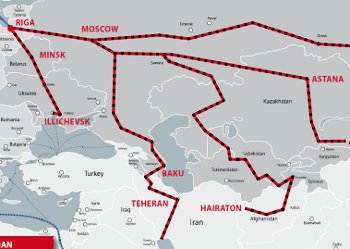Celebration of the 100,000th Container along the NDN
June 11, 2013
On June 11th, Ambassador McCarthy visited Riga Free Port to participate in a celebration of the 100,000th container to pass through the Northern Distribution Network, which includes Estonia, Latvia and Lithuania, to Afganistan, organized U.S. Embassy in Riga, in cooperation with the Latvian MFA and Ministry of Transport.
Among the senior diplomats present at the event were U.S. Deputy Assistant Secretary of State for South and Central Asia Lynne Tracy, the U.S. Ambassadors to Latvia Mark Pekala, Latvian Foreign Minister Edgars Rinkevics,Latvian Minister of Transportation Anrijs Matiss as well as other U.S. military officials.
Initially activated in 2009, the route has brought more than 2 million tons of nonlethal equipment through ports in the Baltic nations of Latvia, Lithuania and Estonia and then overland into Afghanistan to support operations. The route traverses the Czech Republic, Slovakia, Hungary, Romania, the Black Sea, Georgia, Azerbaijan, Kazakhstan, Uzbekistan, Kyrgyzstan and Tajikistan before reaching Afghanistan.
The route was created as an alternate way to move supplies into Afghanistan instead of depending on a single route through Pakistan. It is one of the longest lines of military supply lines ever created, according to U.S. Army Col. Matthew Redding, commander of the 598th Transportation Brigade in Sembach, Germany. His unit coordinates the logistical effort through U.S. Transportation Command’s Surface Deployment and Distribution Command.
“The 100,000th container is not the story, that is simply a number,” said Col. Redding. “What is really important is the Baltic cooperation and the ability to link it to our foreign policy as it relates to the entire region.”
The route requires close cooperation between not only nations but U.S. Transportation Command, U.S. Army Europe, the U.S. State Department and its embassies, as well as the commercial entities that contract for the transport.
“It represents cooperation amongst our agencies in the U.S,” said Ambassador McCarthy. “The DoD and Department of State cooperation has been vital in the last few years. It’s also a celebration of our ability to work with foreign governments thinking about not only a common cause in Afghanistan, but about the future of Central Asia.”
The ceremony also set the stage for a conference June 12 in Riga discussing the future of the network as a means for withdrawing equipment from Afghanistan as 2014 approaches, and the expansion of the route for commercial purposes.
“We are trying to create, on the basis of the Northern Distribution Network, a whole new way of thinking about transportation and logistics in this region,” said Ambassador Pekala. “Latvia and the other Baltic states could be the center of what they call a new Silk Road … a 21st-century logistics and transportation hub. This represents how that can be achieved working together on the basis of free enterprise, democracy and cooperation.”
Source: Embassy of the United States, Lithuania
Not like the WWII Persian Corridor, where the volume of traffic was censored!

